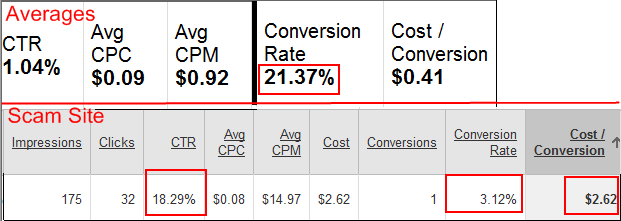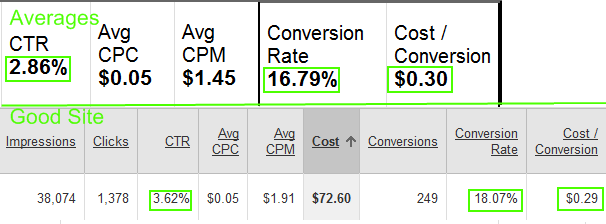I have been using Google Conversion Optimizer since late September. The program has been extraordinarily successful for me, enabling me to double revenues (and profit margin) in a month. This post recounts my experiences.
Who I Am: I sell software which creates bingo cards to teachers. The goal of my advertising campaign is to get them to download a free trial. Some portion of those who download a free trial purchase the full product, making me money.
What Content Network Is: Conversion Optimizer (hereafter CO) is a way of bidding on the AdWords Content Network, which is all those little ads you see plastered on non-Google websites. Typically, on the Content Network you write up a list of keywords, write up a maximum bid per click on each keyword, write some ads, and then get charged as the ads get clicked on on any site Google thinks matches your keywords.
How Converison Optimizer is different: With CO, you don’t specify how much a keyword is worth to you. You specify how much a conversion is worth to you. Google then guesses, based on your previous history, what CPC (cost per click) price will achieve your CPA (cost per action) goal at any particular website, and bids accordingly on your behalf. I like to think of this as pseudo-CPA bidding, since its really just a wrapper around CPC bidding. Google has a beta CPA product that I haven’t tried yet, and probably never will, because CPA bidding has some severe issues for publishers which will make it perpetually less popular than CPC bidding. There aren’t enough publishers in my market interested in CPA bidding to make it worth my while to start a campaign.
My Experience With The Content Network Prior to Conversion Optimizer:
Endless frustration pretty much sums it up. When I started advertising on Google last September the content network was on by default. At the time it was filled with Made for AdSense (MFA) sites, which scrapped content and existed only to get clicks. They got clicks, but the traffic I got was extremely low quality, and they drained my AdWords budget dry. I was advised by knowledgeable folks at the Business of Software boardsthat the Content Network was a hive of scum and villany. I turned off the Content Network, advised everyone else to turn off the Content Network, and went on building my business for the better part of a year.
Why I Came Back to the Content Network: A professional peer who produces language learning software told me he had had excellent success with the Content Network. I am skeptical about most people opining on the Internet but I have a good deal of trust for him and, moreover, I trust data. Google had in the interim cleaned up some of their click fraud problems and shared Placement Reports with advertisers, which let you see which sites were running your ads and what their individual conversion rates, CPC prices, click through rates (CTR), and whatnot were. With that data, I thought I could make something of the Content Network.
So things went well? No, actually, they sucked for quite a while. I got trapped in an endless cycle of checking my Placement Report every day, banning whatever flavor-of-the-moment site was abusing their own visitors to misdirect folks into clicking on the ad by disguising it as content (n.b. the site owner featured there says it was an accident, and I believe him, but I was getting a new site using a similar technique two to three times a day), and losing the money I had allocated. I have a day job at a Japanese company, with a 3 hour commute. When I get home at 11 PM at night, I don’t want to sit down and have to immediate check AdWords to see if my pocket is getting picked yet. I was right about to turn off the Content Network again when CO debuted. I jumped at the chance, and became one of their earlier advertisers.
Anatomy of a bad site to advertise on:
Let me pull you an anonymized entry out of my Placement Report, and compare it to my averages. These images are digitally edited composites of my AdWords status screens — I haven’t changed any numbers, but I have removed some to make the narrative clear. If you are reading this on WordPress.com and not on a feed reader, the image is truncated — click it to see the full size.

As you can see, the bad site has a CTR much, much higher than my average CTR. This is because their site is designed to funnel their own visitors onto the ad, which is disguised as content. Notice the conversion ratio is terrible. This is exactly what we would expect — since they were tricked to click on the ad, they have no real interest in downloading a free trial of my software, and click the back button to try to find what they were looking for on the dishonest site. This drives my Cost Per Conversion through the roof (incidentally, my goal is 30 cents, and break even is about 60 cents).
Multiply that one dishonest site by about 20 or so, with more showing up every day, and you’ll understand my frustration with the Content Network.
Anatomy of a Good Site on the Content Network:

Here, on the other hand, we have a good site on the Content Network. They wrote a page with unique, original content which is useful to folks in my niche and which got them in the right mood to need Bingo Card Creator. Then, in a perfectly honest fashion, they had ads after their content that folks could click on if they were interested. You’ll note that while 3.62% is a very good CTR it isn’t outlandishly, unbelievably good like 20%. You’ll also note that their conversion rate is high (18%, a bit above my average for content network, which underperforms organic and paid search), and that I am actually profiting from this site. Substantially.
Heck, I’ll out the good site: it is About.com’s page on Halloween bingo. Thank you, About.com, you made me about $250 in October. I salute you.
Where Conversion Optimizer Comes In:
You’ll note that the major observable difference in the numbers between Bad Sites and Good Sites is that Cost Per Conversion value. Heck, from my point of view, that is the major reason why they are bad: if I pay $3 for a trial download, which converts at approximately 2.5% to a $25 purchase, I am spending $120 to make $25. Not a good idea, and I’m supporting the pollution of the Internet in the bargain. If I pay 30 cents, I am spending $12.50 to make $25, and supporting good content creation. Good idea!
Conversion Optimizer makes me bid on Good sites, not on Bad sites. And that is why it works phenomenally, phenomenally well. If I advertise on Bad site, their CPA price is through the roof for a day, and Conversion Optimizer silently and automatically makes sure I never send them an impression ever again. Conversely, if I bid on a Good site, Conversion Optimizer analyzes how profitable that site is and steadily ups my bid so I can capture as much traffic as possible while remaining profitable. This is why all of my Good sites with any volume hover right around the $.30 cents CPA. (My bid is 35 cents.)
How Conversion Optimizer Is My Own AdWords Manager:
My market is very seasonal, and ideally I would be writing a new ad, ad campaign, and landing page for every major holiday, the start and stop of the school term, and whatnot. But who has the time? I was working 60 hour weeks in late October and, while I made some effort to capture the coming Halloween traffic, I couldn’t spend many hours on optimizing the heck out of my pages.
But why write landing pages when the rest of the Internet has already done it? There are many, many pages out there extolling the fun of Halloween bingo and lamenting how hard it is to actually make the cards for it. About half of the ones in the Google top 10 for relevant queries run AdSense. They saw major traffic as Halloween approached, and that traffic was highly, highly motivated to play Halloween bingo… and my ad was in front of all of them, NOT because I had had the brainstorm “Hey, I should get the Advertising Department working on a coordinated campaign to shove 80% of my advertising budget into Halloween bingo” but because a soulless algorithm decided “Hmm, Bingo Card Creator is having its best return on investment on these sites. I’ll put most of his advertising there.” Its like my own private campaign manager… who works for no salary. Lets have a scary Halloweenish Mwahaha! for that.
The Before and After Picture:
CTR 2.23% vs .5-1% (up by a factor of four. This makes it easier for me to get cheaper clicks, because AdSense prefers to show ads which generate income rather than just having high bids.)
CR 18% vs 20-25% (not a significant change)
CPC 6 cents vs 9 cents (costs down by about a third, nice enough, but wait for it…)
Profit $500 vs $10 (Note that since my business previously profited about $700 a month, that is sort of a nice boost)
Wait a second, how did it make that much?
By scaling. Conversion Optimizer, unlike my hand-edits to AdWords, just kept scaling as I tossed more money at it. I ended up with an AdWords bill in the hundreds, to be sure, but I ended up with a 100% ROI on the hundreds, instead of ending up with a 20% ROI on my previous tens.
Is it continuing?
The Halloween spike has subsided, and the Optimizer isn’t spending all of my budget allocation every day anymore (sadly), but Thanksgiving is right around the corner… And I don’t have to do anything to prepare for it this year — the clicks will come straight to me, from whatever the Optimizer decides are the most worthwhile Thanksgiving bingo sites on the Internet as measured by their actual success in making me money.
Bonus Points:
It is difficult to tell if this number is totally accurate, because Google’s conversion tracking is sometimes lackluster, but I believe my trial-to-purchaser conversion rate on Conversion Optimizer-generated trials was about 4% as compared to my typical 2-2.5% number. I attribute this partially to Halloween seasonality and partially to Conversion Optimizer finding me only the most motivated prospects, instead of folks who in aggregate didn’t really need Bingo Card Creator. Obviously, increasing that conversion rate by 60-100% has a corresponding direct impact on my ROI.
Any bad news?
You can’t use Conversion Optimizer if your Content Network campaign gets less than 300 conversions a month. When I spoke with one of the product managers he told me that was unlikely to change, as there are statistical significance issues below that number and the engineering team doesn’t think they can push it any lower. I feel for you guys with CPAs in the $10 range, as I wouldn’t want to have to risk $3,000 on an unproven and relatively new product either.
There is also some tin-foil-hattery about giving Google enough information to guess where your profitability is. In the end, I think as long as I get trial downloads at 30 cents in quantity I could care less if I gave up all of my customer surplus (econ term) from a smaller number of trial downloads achieved at under 30 cents each. As you can see, the absolute number of dollars the campaign puts in my pocket exploded with Conversion Optimizer.
In a Nutshell:
Conversion Optimizer just made me a whole lot of money. I recommend you try it out if it sounds like a good thing for your business’ unique circumstances.
Like this post? This blog contains nothing but real experiences with real numbers about advertising, SEO, customer service, and every other aspect of running an online business. If that sounds interesting to you, sign up for the feed. If you know someone in the market for software to make bingo cards, I’d greatly appreciate a mention.





Recent Comments